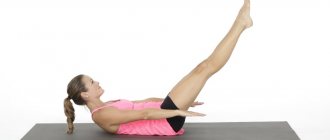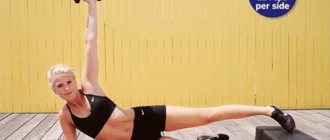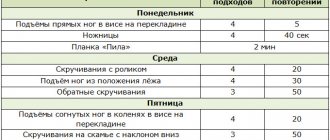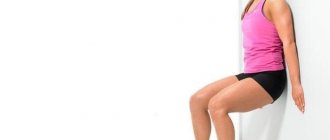This article is about how you can pump up your abs by training on a machine specially designed for this. It not only makes the process of doing exercises easier compared to conventional crunches on the floor, but also allows you to carry out exercises as efficiently as possible. I would also like to add that exercises on the abdominal bench help develop not only the abdominal muscles, but also strengthen the back and buttocks.
What is an ab bench?
A board or bench for the press is sports equipment for training the abdominal and lumbar areas of the body. Exercises on a bench for the press allow you to tighten your abdominal muscles and form a beautiful relief.
The design can be of several types:
- Straight, has a horizontal surface, not adjustable. Suitable at the initial stage of working out the abs. Inexpensive option for beginners.
- Curved, assumes more serious loads. Price – from 2.5 – 3.5 thousand rubles.
- Board with adjustable tilt angle. The adjustable backrest makes it possible to pump individual muscle groups at different angles. The cost is about 5 thousand rubles.
- Roman bench. The projectile is equipped with fixing leg bolsters and a small seat; there is no back support. The simulator is intended for advanced athletes in good physical shape. The price of the equipment depends on the manufacturer.
A board for pumping up the abs is available in almost every gym. Equipment for home training should be purchased taking into account the individual characteristics and level of athletic training of a person.
The design should be easy to install and adjust, have a wide and soft base. The best option is folding boards. They are quite functional and do not take up much space.
Contraindications
Not everyone can work on their abs on a special board.
Exercising on a bench is contraindicated for people with the following health restrictions:
- back injuries, lumbar injuries;
- undergoing spinal surgery;
- hernia;
- acute gastrointestinal disorders.
Without a strong back, doing abs training is quite difficult. Weak muscles will not allow you to maintain constant tension when doing crunches, the lower back will be strongly arched, and the stomach will be relaxed.
It is impossible to make progress without proper technique.
General rules for performing exercises, how many approaches to do
In order to conduct quality training, it is necessary to comply with certain requirements when performing:
- the pelvis is pressed tightly against the support;
- the stomach is tense;
- neck straight;
- the spine is slightly bent.
Exercises should be performed slowly, without making sudden movements. An acceptable number of sets is 3, 12-16 repetitions each.
Self-pumping of the press should not be carried out earlier than 2 hours after eating. The best time is at the end of the main complex.
Exercising too frequently leads to an increase in waist size. For girls, it is enough to do one or two preparations a week. To avoid overtraining, the body requires 3-4 days of rest to recover.
Best exercises
Workouts can be done both at home and in the gym. The effect of training using the structure is achieved much faster than with conventional crunches on the floor.
Various techniques allow you to work out the abdominal area and back. Depending on the task and sports experience, everyone can create a suitable set of exercises and choose the appropriate level of load.
For those who are taking their first steps towards a sculpted body, there is no need to use additional weights. Bodyweight training is productive until the muscles have fully adapted to the activity being created.
Straight crunches
Straight crunches are number one on the list of abdominal exercises. Beginners or experienced athletes must include sit-ups in their torso pumping plan.
The exercise strengthens and tightens the rectus abdominis muscle, forms a beautiful relief, drawing the desired cubes.
Before you begin, you need to select the right equipment. The higher the angle of inclination of the board, the more difficult the load.
Technique:
- Lie with your back on the machine, place your palms on the back of your head.
- Place your knees under the upper clamps, secure your feet behind the lower bolsters.
- Raise your torso up, perpendicular to the floor, hold for 3-5 seconds.
- Slowly lower yourself, but not completely, do not relax your stomach.
Step by step video tutorial below
Oblique crunches
Work on the oblique muscles will be carried out while maintaining the original position, as with straight lifts. The difference is that the torso must be alternately turned to the sides while moving upward.
Scheme for performing lateral twists:
- Take a position on the board, bring your legs under the fixing rollers.
- Perform lifts and turns, with the right elbow moving towards the left leg and vice versa.
- When returning to the starting point, the lower back should not touch the support.
A visual performance of lateral lifts is shown in the video below.
Leg Raise
Throwing your legs from a lying position on an inclined bench allows you to pump up the lower part of the rectus abdominis muscle well. This type of load is called reverse twisting.
How to do it:
- Position yourself on the board, with your head at the top edge of the projectile.
- Grasp the handles tightly with your palms.
- Stretch your legs parallel to the floor, tighten your stomach.
- Raise your straight legs with your toes towards the ceiling, your pelvis is extremely raised.
- The spine, at the moment of throwing the limbs, should be rounded.
- Slowly return to the starting position.
- Complete 2 sets of 12 repetitions.
A visual demonstration of the correct technique for performing reverse crunches is presented in the video below.
Bike
The classic version of the bicycle is familiar to every novice athlete. The popular method of creating a thin and sculpted waist area can be made a little more complicated by doing it not on the floor, but on a board.
How to do it:
- Lie on an inclined surface, place your head at the top of the structure.
- Grasp the supports with your hands.
- Raise your legs parallel to the floor.
- Bend and pull the right leg towards the chest, simultaneously stretching the left, then vice versa.
The work is carried out at a slow pace, the stomach is as tense as possible throughout the entire complex.
Below is a video instruction on the technique of performing a bicycle crunch in a horizontal position.
We pump the abdominal muscles correctly on an inclined board
When working on a bench, it is necessary to take into account, first of all, the general principles of working on the abdominal muscles:
- while performing movements, the muscles should be tense all the time; they should not be relaxed until the end of the approach;
- flexion of the body is performed while exhaling, and extension - while inhaling;
- It is not recommended to press your chin to your chest, as this can lead to spinal injuries;
- It is best to make movements slowly;
- increasing the load can be done by changing the angle, increasing the number of repetitions and approaches, as well as adding weights;
- Do not make jerky movements.
The number of sets and repetitions will depend on your goals. When working on weight, it is better to do no more than 12-15 times; if it becomes easy, you can add weights. If the goal is to lose excess fat or work on relief, then it is better to pay attention to high-repetition training, from 20 times per approach.
Attention! It is worth choosing 2-3 exercises and doing 3-4 approaches when working on weight, up to 5-6 when losing weight. A larger amount will not bring results; it is better to devote time to exercises on other muscle groups.
An incline bench has its benefits. It allows you to adjust the angle, thereby adjusting the load. Before you start swinging correctly on an incline, you need to master the technique and some rules:
- The exercise is performed only after warming up. It is recommended to first do 1-2 approaches on a horizontal plane without weights, as well as a general warm-up of the body;
- the legs must be properly secured using a special fastening;
- Body lifts can be performed with or without twisting.
The exercise technique will be approximately the same as when performing regular body lifts on a horizontal bench, with the difference that the movements are carried out in a position where the legs are above the head. The essence of an incline bench is that its use will shift the load to the lower part of the press, which is most often a problem area.
Tips and Tricks
The success of the practical part of the classes is largely ensured by correctly mastered theory. By correctly understanding the meaning of each element in the exercise, it is easier for the athlete to achieve his goal.
Many fitness trainers, based on many years of practice and reviews from their clients, advise not to neglect some effective techniques in working out the abdominal muscles:
- follow the formula: regimen - proper nutrition - sports;
- adhere to the optimal training schedule for the week: 2 days of training, 5 days of rest;
- the main thing is not the number of repetitions, but the quality of execution, concentration on every centimeter at the moment of muscle contraction;
- maintain respiratory balance throughout the training: inhale when extending the body, exhale when bending over;
- work to failure, “finishing off” the muscles with a couple of incomplete repetitions.
If the exercise is performed too easily, then the result will not be achieved. Each repetition of the movement must be performed through effort. The greater the resistance, the more productive the process.
Technique for performing the book exercise on a bench
It is considered standard to perform the book exercise on a bench. With this technique, it is easier to control tension and involve the abs more in the work, rather than the legs.
Technique:
- Sit on the edge of a bench (or on a stable stool, chair, fitness cabinet), bring your legs together and put them forward with your knees slightly bent. Place your hands on the edge of the bench and tilt your body back.
- Raise your legs, bend them at the knees and pull them towards you. At the same time, move your body forward (your chest moves towards your knees).
- Pause for 1 second as you exhale, then return to the starting position.
It is important to understand how to do the exercise and maintain tension in the target zone. To do this, you cannot lower your feet to the floor throughout the entire approach, which will allow you to maintain tension in the press.
Typical beginner mistakes
Serious sports training does not tolerate carelessness or deviations from the rules. Any inaccuracy can lead to injury or sprain. Before proceeding directly to the training, you should study the technical nuances and features of working with the projectile.
Novice athletes, due to inexperience, quite often make the same mistakes:
- Separation of the lower back from the support, or a strong deflection of the body. Such actions can overload the hip area and remove stress from the abdominal muscles.
- Holding your breath while working. Timely supply of air saturates all cells and tissues of the body with oxygen. Holding your breath is a dangerous mistake that can harm the nervous system.
- Neglecting the recommended standards for the number of repetitions and approaches.
- Implementing daily ab pumping is a typical and gross misconception for beginners.
- Conducting a workout on a full stomach. To prevent unpleasant reactions such as vomiting and nausea, at least 1.5-2 hours should pass after eating. Shortly before training, it is not recommended to have a heavy lunch. A light snack is a good option before class.
Possible mistakes
There are a number of inaccuracies that beginners make while completing the “book”:
- Rounded back (this cannot be done, since the load from the abdominal muscles is transferred to the latissimus muscle);
- Lifting “in jerks”, at a fast pace (movements should be smooth);
- You should not move your head during the exercise - this can “load” the muscles of the neck, not the abs;
- You should not immediately return to the starting position after lifting - it is better to linger at the extreme point for a few seconds.
The “book” is included in a comprehensive training of the abdominal muscles (the frequency of the exercise is twice a week).
In fitness, the fold exercise is considered simultaneously one of the simplest and incredibly difficult movements. It is accessible even for beginners, but a high level of physical fitness is required to get the full effect. Also, the abdominal fold is the only exercise that engages the entire abdominal area at the same time.











